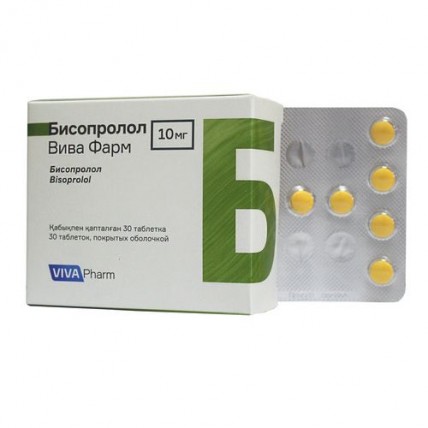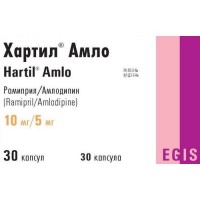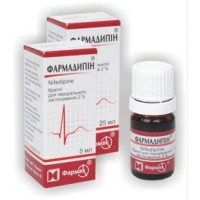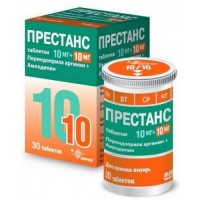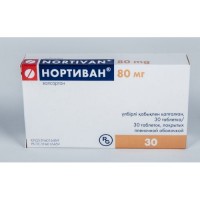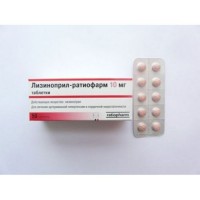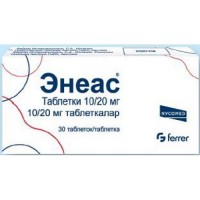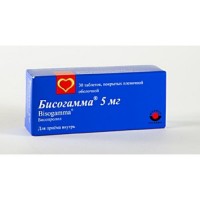Bisoprolol Viva Pharm 30s 10 mg coated tablets
- $5.70
The instruction for medical use of Bisoprolol medicine of Viv the Pharmaceutical Trade name Bisoprolol of Viv the Pharmaceutical International unlicensed name Bisoprolol Lekarstvennaya the Tablet form, coated, 2.5 mg, 5 mg and 10 mg Structure One tablet contains active agent - the bisoprolola fumarates 2.5 mg, 5.0 mg or 10.0 mg excipients: hydrophosphate calcium dihydrate, cellulose microcrystalline (102), starch prezhelatinizirovanny, polyvinylpirrolidone (коллидон®), aerosil, magnesium stearate, structure of a cover: Opadry® OY-S-28924 (a gipromelloza, the titan dioxide (E171), a polyethyleneglycol/macrogoal) – for a dosage of 2.5 mg, Opadry® Yellow 03B62519 (a gipromelloz, the titan dioxide (E171), talc, a polyethyleneglycol/macrogoal, ferrous oxide yellow (E172)) – for a dosage of 5 mg, Opadry® Yellow 03B52246 (a gipromelloz, the titan dioxide (E171), talc, a polyethyleneglycol/macrogoal, ferrous oxide yellow (E172)) – for a dosage of 10 mg. The description of the Tablet of round shape with a biconvex surface, coated white color (for a dosage of 2.5 mg). Tablets of round shape with a biconvex surface, coated light yellow color (for a dosage of 5 mg). Tablets of round shape with a biconvex surface, coated yellow color (for a dosage of 10 mg). Pharmacotherapeutic group Cardiovascular system. Beta blockers. Selection beta blockers. Bisoprolol. The ATX C07AB07 code the Pharmacological Pharmacokinetics Later properties of oral administration bioavailability of a bisoprolol makes 90%. Distribution volume − 3.5 l/kg. Linking with proteins of blood plasma reaches about 30%. Bisoprolol is brought from an organism in two ways. About 50% are metabolized in a liver with formation of inactive metabolites which then are allocated with kidneys. Other 50% are removed with urine in not changed look. The general clearance is about 15 l/hour. Plasma elimination half-life of blood makes 10-12 hours. The kinetics of a bisoprolol linear also does not depend on age. Special groups of patients the Pharmacokinetics at patients with the stable chronic heart failure (CHF) and impaired renal function or a liver was not studied. At patients with chronic heart failure (functional class III on classification of the New York association of heart (NYHA)) concentration of a bisoprolol in blood plasma and elimination half-life is more in comparison with indicators at healthy volunteers. The pharmacodynamics Bisoprolol − high-selection β1-адреноблокатор, has no internal sympathomimetic and membrane stabilizing activity. Has low affinity to β2-рецепторам smooth muscles of bronchial tubes and vessels and to β2-рецепторам enzymatic metabolic regulation. Thus, bisoprolol, as a rule, does not influence resistance of airways and the beta2-mediated metabolic processes. Its beta1-selectivity exceeds the limit of range therapeutic dosed It is known that the bisoprolol has no negative inotropic effect. The maximum effect of a bisoprolol is reached in 3-4 hours after oral administration. Elimination half-life (10-12 hours) provides 24-hour efficiency at administration of drug once a day. Generally, the maximum antihypertensive effect of a bisoprolol is reached after 2 weeks treatment. At therapy of acute conditions of patients with coronary heart disease without chronic heart failure, bisoprolol reduces heart rate and reduces stroke output that leads to decrease in fraction of emission and consumption of oxygen. At therapy of chronicities originally increased peripheric resistance decreases. Decrease of the activity of renin of plasma is the cornerstone of antihypertensive effect of beta-blockers. Bisoprolol suppresses the answer to simpatoadrenergichesky activity by blocking of cardiac beta1-receptors. This effect causes delay of heartbeat and decrease in contractility that leads to decrease in consumption by an oxygen myocardium. The last causes desirable effect in patients with stenocardia and coronary heart disease. Indications - treatment of stable chronic heart failure with reduced systolic function of a left ventricle, in addition to inhibitors of angiotensin-converting enzyme (iAPF) and diuretics, and, perhaps, cardiac glycosides - arterial hypertension - coronary heart disease (stable stenocardia) the Route of administration and doses Pharm should take the Drug Bisoprolol of Viv in the morning regardless of meal. Tablets should be washed down with a small amount of liquid. Tablets should not be chewed. Treatment of arterial hypertension and coronary heart disease (stable stenocardia) the Recommended dose of a bisoprolol for both indications makes 5 mg once a day. If necessary it is possible to increase a dosage to 10 mg once a day. The maximum recommended dose of the drug Bisoprolol of Viv Pharm makes 20 mg once a day. The dosage of drug has to be selected individually, depending on the clinical answer and an indicator of the heart rate (HR). Therapy by the drug Bisoprolol of Viv Pharm usually is long. Do not interrupt sharply treatment and do not change the recommended dose without consultation with your doctor as it can lead to temporary aggravation of symptoms. Especially it is not necessary to interrupt suddenly therapy at patients with coronary heart disease. If suspension of treatment is necessary, the dose has to decrease gradually (within 1-2 weeks). Treatment of the stable chronic heart failure (CHF) Standard treatment of HSN consists of iAPF (or, in case of intolerance of iAPF, a blocker of receptors of angiotensin), a beta-blocker, diuretics, and in case of need cardiac glycosides. At treatment initiation bisoprololy the condition of patients has to be stable (without acute heart failure). It is desirable that the attending physician had experience of treatment of patients with HSN. A dose the Initiation of treatment of stable chronic heart failure the drug Bisoprolol of Viv Pharm demands obligatory carrying out a special phase of titration. Treatment of chronic heart failure the drug Bisoprolol of Viv Pharm begins according to the following scheme of gradual titration of a dose. The dose can be increased only in case the previous dose was well transferred. 1 week of 1.25 mg of a bisoprolol fumarates (1/2 tablets Bisoprolol of Viv of Pharmaceutical 2.5 mg) daily once a day the 2nd week of 2.5 mg of a bisoprolol the 3rd week of 3.75 mg of a bisoprolol fumarates (1 tablet Bisoprolol of Viv of Pharmaceutical 2.5 mg) daily once a day 4-7 week of 5 mg of a bisoprolol fumarate (1.5 tablets Bisoprolol of Viv of Pharmaceutical 2.5 mg) daily once a day 8-11 week of 7.5 mg of a bisoprolol fumarate daily once a day * the 12th week fumarates daily once a day * and after 10 mg of a bisoprolol fumarates daily once a day as maintenance therapy * * Bisoprolol of Viv of Pharmaceutical 2.5 mg is suitable for initial treatment of stable chronic heart failure. Higher dosages are suitable for maintenance therapy. The maximum recommended dose of a bisoprolol of the fumarat makes 10 mg once a day. Individual adaptation depending on that can be required, how well the patient transfers the appointed dose. During a phase of titration and after it temporary deterioration in heart failure, hypotension or bradycardia can be observed therefore careful observation of vital signs (arterial blood pressure, ChSS) and symptoms of progressing of heart failure is required. Symptoms can appear in the first day of treatment. Treatment modification If the maximum dose is badly transferred by the patient, revision of a dosage towards gradual decrease is recommended. If temporary deterioration in heart failure is observed, hypotension or bradycardia develops, revision of a dosage of the accompanying drug is recommended. Also temporary decrease in a dosage of a bisoprolol or suspension of treatment can be required. Continuation of treatment and/or repeated titration should be carried out after stabilization of a condition of the patient. If it is necessary to suspend treatment, the dose has to decrease gradually (within 1-2 weeks) as the sharp termination of therapy can cause aggravation of symptoms of heart of the patient. Therapy of stable chronic heart failure the drug Bisoprolol of Viv Pharm usually is long. Special groups of patients the Renal failure or a liver or kidneys of easy or moderately severe correction of the mode of dosing, as a rule, are not required to Patients with abnormal liver functions. For patients with heavy renal failures (clearance of creatinine & lt, 20 ml/min.) and patients with heavy abnormal liver functions the maximum daily dose makes 10 mg. There is only a limited experience of use of a bisoprolol at patients on dialysis which does not indicate the need to correction of the mode of dosing. Elderly patients: Dose adjustment is not required. Patients of children's age there Is no information on use of a bisoprolol for patients of children's age. Use of a bisoprolol for children is not recommended. Side effects the Frequency of side effects of drug is defined as follows: very often (≥ 1/10), it is frequent (≥ 1/100, & lt, 1/10), infrequently (≥ 1/1000, & lt, 1/100), is rare (≥ 1/10,000, & lt, 1/1000), is very rare (& lt, 1/10,000), frequency is unknown (it cannot be established on the basis of the available data). Disturbances from mentality: Infrequently: sleep disorder, depression. Seldom: nightmares, hallucinations. Disturbances from nervous system: Often: dizziness *, head bol*. Seldom: syncope. Disturbances from organs of sight: Seldom: decrease in a slezootdeleniye (that should be considered at use of contact lenses). Very seldom: conjunctivitis. Disturbances from an organ of hearing and balance: Seldom: hearing disorder. Disturbances from heart: Very often: bradycardia. Often: aggravation of symptoms of heart failure. Infrequently: disturbances of atrioventricular conductivity, bradycardia (at patients with hypertensia and stenocardia), aggravation of symptoms of heart failure (at patients with hypertensia and stenocardia). Disturbances from vessels: Often: cryesthesia or numbness in extremities. Infrequently: orthostatic hypotension. Disturbances from the respiratory system, bodies of a thorax and mediastinum: Infrequently: a bronchospasm at patients with bronchial asthma or an obstructive respiratory disease in the anamnesis. Seldom: allergic cold. Disturbances from digestive tract: Often: disturbances of work of digestive tract, such as nausea, vomiting, diarrhea, constipation. Disturbances from a liver and biliary tract: Seldom: hepatitis. Disturbances from skin and hypodermic fabrics: Seldom: reactions of hypersensitivity (itching, reddening, rash). Very seldom: alopecia. Beta-blockers can provoke or aggravate psoriasis symptoms, or cause rashes, characteristic of psoriasis. Disturbances from skeletal and muscular and connective tissue: Infrequently: muscle weakness and spasms. Disturbances from genitals and a mammary gland: Seldom: disturbance of potency. General disorders: Often: weakness, fatigue * Laboratory indicators: Seldom: increase in level of triglycerides, increase in level of enzymes of a liver (ACT, ALT). Concerns only hypertensia and stenocardia: * Symptoms usually arise at the beginning of therapy, have easy degree and often pass after 1‑2 weeks of treatment. It is necessary to inform the attending physician at detection at himself any of the listed side effects, or any other undesirable or unexpected effects. Contraindications - an acute heart failure or heart failure in a stage of a decompensation which demands intravenous inotropic therapy - cardiogenic shock - atrioventricular block of II and III degree (without electrocardiostimulator) - a sick sinus syndrome - sinuatrial blockade - symptomatic bradycardia - symptomatic hypotension - severe forms of bronchial asthma and chronic obstructive pulmonary disease in the anamnesis - late stages of a peripheral arterial occlusive disease or a Raynaud's disease - not treated pheochromocytoma - a metabolic acidosis - hypersensitivity to a bisoprolol or to any of drug components - children's age up to 18 years (the efficiency and safety are not established) - pregnancy and the period of a lactation With care - a hypertension or stenocardia with the accompanying heart failure - a bronchospasm (bronchial asthma, obstructive diseases of lungs) - diabetes with considerable fluctuations of level of glucose in blood, hypoglycemia symptoms (for example, tachycardia, a cardiopalmus or perspiration), which can be disguised - a rigid diet - the continuing desensibilizing therapy - the first extent of AV-blockade - Printsmetal's stenocardia - a peripheral arterial occlusive disease (complaints, especially at the beginning of therapy can increase) - to patients who in the anamnesis have a psoriasis beta-blockers (for example, bisoprolol) have to be appointed only after careful assessment of advantage/risk. Medicinal interactions the Concomitant use of other drugs can affect effect and tolerance of drug. Similar interactions can also happen if from the moment of acceptance of other drug there passed not enough time. Inform your attending physician if you take any other drugs. Simultaneous use with the following drugs is not recommended: Antagonists of calcium of type of verapamil and, to a lesser extent, diltiazem at simultaneous use with bisoprololy can lead to decrease in sokratitelny ability of a cardiac muscle and delay carrying out atrioventricular impulses. In particular, intravenous administration of verapamil to the patients receiving therapy by beta-blockers can lead to deep hypotension and atrioventricular block. Antihypertensive drugs of the central action (such as clonidine, Methyldopum, moksonidin, rilmenidin) can lead to reduction of ChSS and warm emission and also to a vazodilatation owing to decrease in the central sympathetic tone. Sharp cancellation, especially before cancellation of beta-blockers can increase risk of developing "ricochet" hypertensia. With care to apply with the following drugs: Antiarrhytmic means of class I (for example, quinidine, Disopyramidum, lidocaine, Phenytoinum, flekainid, propafenon): influence time of atrioventricular conductivity and also the negative inotropic effect can increase. Blockers of calcium channels as dihydropyridine (for example, nifedipine): combined use can increase risk of hypotension and also disturbance of delivery function of ventricles at patients with heart failure is not excluded. Antiarrhytmic means of class III (for example, Amiodaronum): strengthening of influence on time of atrioventricular conductivity is possible. Parasympathomimetics: combination therapy can increase time of atrioventricular conductivity and increase risk of bradycardia. Topical administration of beta-blockers (for example, eye drops for treatment of glaucoma) can enhance system effect of a bisoprolol. Antihyperglycemic effect of insulin and oral antidiabetic means can amplify. Blockade of beta adrenoceptors can hide hypoglycemia symptoms. The anesthetizing drugs: easing of reflex tachycardia and increase in risk of hypotension. Cardiac glycosides: decrease in heart rate, increase in time of atrioventricular conductivity. Non-steroidal anti-inflammatory drugs (NPVP): can reduce hypotensive effect of a bisoprolol. β-sympathomimetics (for example, Dobutaminum, ortsiprenalin): the combination with bisoprololy can reduce effect of both agents. Sympathomimetics which activate α- and β-receptors (for example, adrenaline, noradrenaline): increase in blood pressure and exacerbation of the alternating lameness is possible. Such interactions are more probable at use of non-selective beta-blockers. Higher doses of adrenaline can be necessary for treatment of allergic reactions. Tricyclic antidepressants, barbiturates, fenotiazina and also other antihypertensive drugs: the enhanced hypotensive effect. At combined
use of the following drugs the following remarks have to be taken into account: Meflokhin: the increased risk of bradycardia. Monoamine oxidase inhibitors (except MAO-B ingibiror): the increased hypotensive effect of beta-blockers and also risk of hypertensive crisis. Special instructions Allergic reactions: As well as in case of other beta-blockers, bisoprolol can increase both sensitivity to allergens, and expressiveness of anaphylactic reactions. In these cases adrenaline can not always provide desirable therapeutic effect. Respiratory system: In bronchial asthma or other chronic obstructive dysfunctions which can be followed by symptoms the accompanying broncholitic therapy is shown. In rare instances at patients with asthma resistance of airways can increase that demands increase in doses β2-симпатомиметиков. General anesthesia: At patients who received the general anesthesia the beta-blockers reduce risk of arrhythmia and ischemia of a myocardium during an introduction anesthesia, an intubation and after operation. Now it is recommended to continue use of beta-blockers perioperatsionno. The anesthesiologist has to be informed that the patient accepts beta-blockers as interaction with other medicines which can lead to bradyarrhythmia, easing of reflex tachycardia and also the lowered reflex ability to prevention of blood loss is possible. If the therapy termination by beta-blockers before operation is necessary, then it has to be carried out gradually and to be fully completed approximately in 48 hours prior to anesthesia. Psoriasis: patients with psoriasis or psoriasis in the anamnesis have to accept beta-blockers (for example, bisoprolol) only after careful comparison of advantage and risk. Pheochromocytoma: To patients with a pheochromocytoma bisoprolol it has to be entered only after blockade of alpha receptors. Thyrotoxicosis: At treatment bisoprololy thyrotoxicosis symptoms can be not revealed. Use of a bisoprolol can result in positive takes of doping tests. Pregnancy Bisoprolol can render side effects at pregnancy and/or on the fruit/newborn. In general, β – adrenoblockers reduce placentary perfusion that contacts a growth inhibition, pre-natal death, abortions or premature births. Side effects (hypoglycemia and bradycardia) can occur both at a fruit and at newborns. Bisoprolol of Viv Pharm is not recommended to use during pregnancy. The lactation period Data on removal of a bisoprolol with breast milk are absent, as well as data on safety of impact of a bisoprolol on newborns. Therefore, feeding by a breast is not recommended during drug use. Features of influence of medicine on ability to run the vehicle or potentially dangerous Bisoprolol mechanisms did not affect ability to drive the car at a research of the patients having diseases of coronary vessels of heart. However owing to individual reactions the ability to drive the car or work with technically difficult mechanisms can be broken. On it it is necessary to pay special attention in an initiation of treatment, after change of a dose and also at simultaneous alcohol intake. Overdose Symptoms: The most widespread signs of overdose of beta-blockers are bradycardia, arterial hypotension, a bronchospasm, an acute heart failure and a hypoglycemia. Treatment: At overdose the therapy bisoprololy has to be stopped, and suitable symptomatic treatment has to be begun. The limited, but available available data allow to assume what bisoprolol is removed by dialysis. Bradycardia: Intravenous administration of atropine. At the inadequate answer, with care can be applied ortsiprenalin or other agents with positive chronotropic properties. Transvenous implantation of an electrocardiostimulator can be in certain cases necessary. Hypotension: Intravenous infusion and introduction of vazopressor. The intravenous glucagon can be also effective. AV-blockade (second or third degree): Patients have to be under careful observation and also they need injection of an ortsiprenalin. If necessary it is necessary to implant transitional pacemakers. Acute deterioration in heart failure: Intravenous administration of diuretics, positive inotropic means and also vazodilator. Bronchospasm: administration of bronchodilators, for example, ortsiprenalin, β2-симпатомиметики and/or Euphyllinum. Hypoglycemia: intravenous administration of glucose. The form of release and packing On 10 tablets pack into blister strip packaging from a film of polyvinylchloride and aluminum foil. On the 3rd blister strip packagings together with the instruction for medical use in the state and Russian languages place in a cardboard pack. To Store storage conditions at a temperature not over 25C. To store out of children's reach! Period of storage 3 years. Not to apply after an expiration date. Prescription status According to the prescription. VIVA Pharm LLP producer, Republic of Kazakhstan 2nd Ostroumova St., 33, Almaty the Holder of the registration certificate of VIVA Pharm LLP, Republic of Kazakhstan 2nd Ostroumova St., 33, Almaty the Name, the address and a contact information (phone, the fax, e-mail) of the organization in the territory of the Republic of Kazakhstan, the accepting claim (offer) on quality of medicines from consumers and responsible for post-registration observation of safety medicinal means: VIVA Pharm LLP, Republic of Kazakhstan 2nd Ostroumova St., 33, Almaty, 050030 ph.: +7 (727) 383 74 63, fax: +7 (727) 383 74 56 e-mail:
To Develop pv@vivapharm.kz
use of the following drugs the following remarks have to be taken into account: Meflokhin: the increased risk of bradycardia. Monoamine oxidase inhibitors (except MAO-B ingibiror): the increased hypotensive effect of beta-blockers and also risk of hypertensive crisis. Special instructions Allergic reactions: As well as in case of other beta-blockers, bisoprolol can increase both sensitivity to allergens, and expressiveness of anaphylactic reactions. In these cases adrenaline can not always provide desirable therapeutic effect. Respiratory system: In bronchial asthma or other chronic obstructive dysfunctions which can be followed by symptoms the accompanying broncholitic therapy is shown. In rare instances at patients with asthma resistance of airways can increase that demands increase in doses β2-симпатомиметиков. General anesthesia: At patients who received the general anesthesia the beta-blockers reduce risk of arrhythmia and ischemia of a myocardium during an introduction anesthesia, an intubation and after operation. Now it is recommended to continue use of beta-blockers perioperatsionno. The anesthesiologist has to be informed that the patient accepts beta-blockers as interaction with other medicines which can lead to bradyarrhythmia, easing of reflex tachycardia and also the lowered reflex ability to prevention of blood loss is possible. If the therapy termination by beta-blockers before operation is necessary, then it has to be carried out gradually and to be fully completed approximately in 48 hours prior to anesthesia. Psoriasis: patients with psoriasis or psoriasis in the anamnesis have to accept beta-blockers (for example, bisoprolol) only after careful comparison of advantage and risk. Pheochromocytoma: To patients with a pheochromocytoma bisoprolol it has to be entered only after blockade of alpha receptors. Thyrotoxicosis: At treatment bisoprololy thyrotoxicosis symptoms can be not revealed. Use of a bisoprolol can result in positive takes of doping tests. Pregnancy Bisoprolol can render side effects at pregnancy and/or on the fruit/newborn. In general, β – adrenoblockers reduce placentary perfusion that contacts a growth inhibition, pre-natal death, abortions or premature births. Side effects (hypoglycemia and bradycardia) can occur both at a fruit and at newborns. Bisoprolol of Viv Pharm is not recommended to use during pregnancy. The lactation period Data on removal of a bisoprolol with breast milk are absent, as well as data on safety of impact of a bisoprolol on newborns. Therefore, feeding by a breast is not recommended during drug use. Features of influence of medicine on ability to run the vehicle or potentially dangerous Bisoprolol mechanisms did not affect ability to drive the car at a research of the patients having diseases of coronary vessels of heart. However owing to individual reactions the ability to drive the car or work with technically difficult mechanisms can be broken. On it it is necessary to pay special attention in an initiation of treatment, after change of a dose and also at simultaneous alcohol intake. Overdose Symptoms: The most widespread signs of overdose of beta-blockers are bradycardia, arterial hypotension, a bronchospasm, an acute heart failure and a hypoglycemia. Treatment: At overdose the therapy bisoprololy has to be stopped, and suitable symptomatic treatment has to be begun. The limited, but available available data allow to assume what bisoprolol is removed by dialysis. Bradycardia: Intravenous administration of atropine. At the inadequate answer, with care can be applied ortsiprenalin or other agents with positive chronotropic properties. Transvenous implantation of an electrocardiostimulator can be in certain cases necessary. Hypotension: Intravenous infusion and introduction of vazopressor. The intravenous glucagon can be also effective. AV-blockade (second or third degree): Patients have to be under careful observation and also they need injection of an ortsiprenalin. If necessary it is necessary to implant transitional pacemakers. Acute deterioration in heart failure: Intravenous administration of diuretics, positive inotropic means and also vazodilator. Bronchospasm: administration of bronchodilators, for example, ortsiprenalin, β2-симпатомиметики and/or Euphyllinum. Hypoglycemia: intravenous administration of glucose. The form of release and packing On 10 tablets pack into blister strip packaging from a film of polyvinylchloride and aluminum foil. On the 3rd blister strip packagings together with the instruction for medical use in the state and Russian languages place in a cardboard pack. To Store storage conditions at a temperature not over 25C. To store out of children's reach! Period of storage 3 years. Not to apply after an expiration date. Prescription status According to the prescription. VIVA Pharm LLP producer, Republic of Kazakhstan 2nd Ostroumova St., 33, Almaty the Holder of the registration certificate of VIVA Pharm LLP, Republic of Kazakhstan 2nd Ostroumova St., 33, Almaty the Name, the address and a contact information (phone, the fax, e-mail) of the organization in the territory of the Republic of Kazakhstan, the accepting claim (offer) on quality of medicines from consumers and responsible for post-registration observation of safety medicinal means: VIVA Pharm LLP, Republic of Kazakhstan 2nd Ostroumova St., 33, Almaty, 050030 ph.: +7 (727) 383 74 63, fax: +7 (727) 383 74 56 e-mail:
To Develop pv@vivapharm.kz
